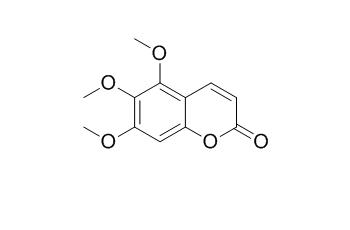5,6,7-Trimethoxycoumarin
5,6,7-Trimethoxycoumarin shows moderate inhibitory activity against Micrococcus luteus, it also displays an intermediate cytotoxic effects against brine shrimp larvae. 5,6,7-Trimethoxycoumarin can improve gastroprotective effects, and it has low toxicity and minimal effects on drug-metabolizing enzymes.
Inquire / Order:
manager@chemfaces.com
Technical Inquiries:
service@chemfaces.com
Tel:
+86-27-84237783
Fax:
+86-27-84254680
Address:
1 Building, No. 83, CheCheng Rd., Wuhan Economic and Technological Development Zone, Wuhan, Hubei 430056, PRC
Providing storage is as stated on the product vial and the vial is kept tightly sealed, the product can be stored for up to
24 months(2-8C).
Wherever possible, you should prepare and use solutions on the same day. However, if you need to make up stock solutions in advance, we recommend that you store the solution as aliquots in tightly sealed vials at -20C. Generally, these will be useable for up to two weeks. Before use, and prior to opening the vial we recommend that you allow your product to equilibrate to room temperature for at least 1 hour.
Need more advice on solubility, usage and handling? Please email to: service@chemfaces.com
The packaging of the product may have turned upside down during transportation, resulting in the natural compounds adhering to the neck or cap of the vial. take the vial out of its packaging and gently shake to let the compounds fall to the bottom of the vial. for liquid products, centrifuge at 200-500 RPM to gather the liquid at the bottom of the vial. try to avoid loss or contamination during handling.
Allergol Immunopathol (Madr).2022, 1;50(4):23-30.
J Biomed Sci.2020, 27(1):60.
Fitoterapia.2021, 153:104995.
Food Chem.2018, 252:207-214
Food Bioscience2023, 53:102687
Food Res Int.2021, 148:110607.
bioRxiv2021, 458409.
Mol Pharmacol.2021, 99(2):163-174.
J Colloid Interface Sci.2022, 622:298-308.
The Pharmaceutical Society of Japan2018, 138(4):571-579
Related and Featured Products
Nutrients. 2015 Mar 13;7(3):1945-64.
Gastroprotective efficacy and safety evaluation of scoparone derivatives on experimentally induced gastric lesions in rodents.[Pubmed:
25781220 ]
Pharmacological studies suggest that the presence of a methoxy group at position C-5 or C-8 of the scoparone's phenyl ring significantly improves gastroprotective activity, whereas the presence of a dioxolane ring at C-6, C-7, or C-8 was found to have decreased activity.
METHODS AND RESULTS:
In order to assess toxicological safety, two of the potent gastroprotective scoparone derivatives-5,6,7-Trimethoxycoumarin and 6,7,8-trimethoxycoumarin-were examined for their acute toxicity in mice as well as their effect on cytochrome P450 (CYP) enzyme activity. These two compounds showed low acute oral toxicity in adult male and female mice, and caused minimal changes to CYP3A4 and CYP2C9 enzyme activity.
CONCLUSIONS:
These results indicate that compared to other scoparone derivatives, 5,6,7-Trimethoxycoumarin and 6,7,8-trimethoxycoumarin can improve gastroprotective effects, and they have low toxicity and minimal effects on drug-metabolizing enzymes.
J Asian Nat Prod Res. 2008 Jan-Feb;10(1-2):49-58.
Irritant and cytotoxic coumarins from Angelica glauca Edgew roots.[Pubmed:
18058380]
Irritant and cytotoxic potentiality of six coumarins, isolated for the first time from the roots of Angelica glauca identified as 5,6,7-Trimethoxycoumarin, 6-methoxy-7,8-methylenedioxycoumarin, bergapten, decursinol angelate, decursin, and nodakenetin, were investigated.
METHODS AND RESULTS:
The irritant potential was explored by open mouse ear assay, evaluating their ID(50) after acute and by IU (Irritant units) after chronic effects, while the cytotoxic capability was explored by their LC(50), using brine shrimp (Artemia salina) larvae (nauplii). All the coumarins exhibited well-defined irritancy on mouse's ears, compared with the positive controlled euphorbium reaction and cytotoxic response against brine shrimp larvae, compared with the positive control colchicine. Decursinol angelate and decursin were the most potent and persistent irritant compounds with least ID(50), whose reactions lasted for 48 h. 6-Methoxy-7,8-methylenedioxycoumarin and bergaten revealed an intermediate irritant reactions, while 5,6,7-Trimethoxycoumarin and nodakenetin displayed the least irritant and least persistent reactions on mouse ears.
CONCLUSIONS:
Both decursin and decursinol angelate also appeared to be the stronger cytotoxic agents than other coumarins. 5,6,7-Trimethoxycoumarin displayed an intermediate cytotoxic behaviour, while other three coumarins, i.e., 6-methoxy-7,8-methylenedioxycoumarin, bergapten, and nodakenetin, exhibited the least cytotoxic capacity against brine shrimp larvae.
J Asian Nat Prod Res. 2013;15(3):270-5.
Two new coumarin glycosides from Chimonanthus nitens.[Pubmed:
23421779 ]
METHODS AND RESULTS:
Two new coumarin glycosides, namely nitensosides A-B (1-2), together with six known compounds, scopolin (3), 5,6,7-Trimethoxycoumarin (4), d-calycanthine (5), calycanthoside (6), xeroboside (7), and scopoletin (8), were isolated from Chimonanthus nitens.
CONCLUSIONS:
The structures of the new compounds were elucidated by comprehensive analysis of IR, MS, and NMR spectroscopic data. Compounds 3, 4, 7, and 8 showed moderate inhibitory activity against Micrococcus luteus.



